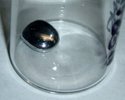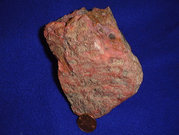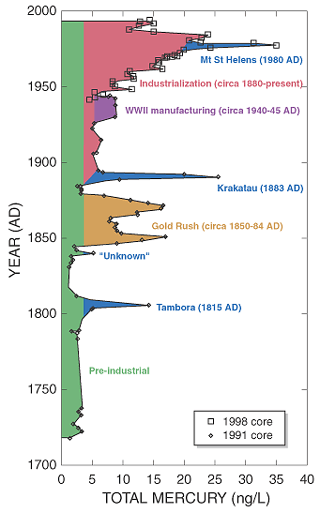Until recently, mercury, the mutable heavy metal, was the common element used in convenience lighting and anti-lock breaking systems in automobiles. The mercury switch, a small metal or glass capsule at the base of the light socket, poses little health concern to consumers during the functional life of the automobiles. However, the switch is sometimes shredded along with the end-of-life car body, and the resulting ferrous scrap is sent off to steel mills. The mercury can then be released into the environment through the steel mills' stacks.
Jeff Gearhart of the Ecology Center, an environmetal group based in Ann Arbor, Mich., says the primary sources of mercury in the environment are coal burning power plants and municipal waste incineration, although a study released by the Ecology Center in January 2001 identified the steel industry as a significant source of mercury emissions.
SOURCES OF MERCURY
"Previously, the steel industry was thought to be an insignificant source of mercury to the environment. Probably in the last two to four years there's been some more extensive emissions testing on the steel industry that has actually begun to document the fact that we do have significant mercury throughput through the industry," Gearhart says.
"We did some mass balance work as part of the report that showed that the auto industry is the primary contributor to those emissions from the steel industry," he continues. "They are not the only one, and we've acknowledged that. White goods, appliances and industrial equipment that contains mercury-containing devices also contribute [emissions]. But we believe the automotive switches are the primary contributor."
Gearhart says that once mercury is released into the air it is deposited into bodies of water and ultimately ends up accumulating in fish. He says that mercury "is persistent in the environment. It doesn't break down. Because of that, it actually bio-accumulates in the fat tissue." This bio-accumulation in fish has lead to consumption advisories, particularly across the Great Lakes states, Gearhart says.
Mercury can cause developmental defects when consumed by children or pregnant woman. It is toxic to the nervous system and a suspected carcinogen, Gearhart says.
Tracy Mattson, director of environmental compliance for the Institute of Scrap Recycling Industries Inc. (ISRI), Washington, says as little as one gram of mercury can cause a significant problem for a 20-acre lake. "That is why we believe that this is so important that it has to be managed properly," Mattson says.
COALESCING EFFORTS
The Partnership for Mercury Free Vehicles, a coalition that combines representatives from the steel and recycling industries as well as those from environmental organizations, is pursuing a system to collect mercury switches from automobiles prior to their being shredded for recycling. The partnership includes ISRI; the Ecology Center; the Automotive Recyclers Association, Fairfax, Va.; the Steel Manufacturers Association, Washington; the Steel Recycling Institute, Pittsburgh; Environmental Defense, New York City; Great Lakes United, Buffalo, N.Y.; Clean Production Network, Lowell, Mass.; and Clean Car Campaign, Ann Arbor, Mich.
Mattson says, "ISRI is working with a partnership because it's an issue bigger than ISRI. It just doesn't affect the scrap industry. It affects everyone who is involved in vehicle recycling as well as the public. That's why you see the environmental groups involved."
She adds that auto dismantlers cannot solely address the mercury problem; a comprehensive solution is required. "States are really taking the lead right now in regard to legislation to address not only mercury in vehicles but in other products."
Gearhart says, "The partnership has developed a piece of model state legislation that we are promoting as a way to deal with the automotive mercury issues at the state level. The key part of that legislation is requiring producer responsibility from the automakers to help finance and recover the mercury switches that are out there in existing vehicles."
In 1995 the auto industry pledged to phase out mercury switches from automobiles. However, an estimated 215 to 250 million mercury switches -- 172 to 200 metric tons of mercury -- are in vehicles presently on the road, according to "Toxics in Vehicles: Mercury," a study conducted by the Ecology Center, Great Lakes United and the University of Tennessee Center for Clean Products and Clean Technologies and released in January 2001.
Mattson says, "not only do you have the scrap industry interested and concerned about this issue, but you have the states, and you have the environmental groups interested. You have the steel folks worried about what this could eventually be doing to their material. And so they are very interested in pursuing a solution."
The solution proposed by ISRI and supported by the Partnership for Mercury Free Vehicles is comprised of five principles:
* Recovery, Collection and Information -- End-of-life and in-use strategies are included in the collection and recovery programs, which target a 90 percent recovery rate for mercury switches. Automakers are called on to take financial and organizational responsibility for collection efforts, which includes collection, transportation and recycling or disposal of devices containing mercury; information on the uses and locations of the switches as well as removal and replacement instructions; and development of a tracking system to monitor the collection program.
* Design for Recycling -- Encourages manufacturers to design products that can be recycled safely and economically using current recycling methods. The program does allow for the use of mercury when no other alternative is available, provided the automaker applies for an exemption, ensures the component can be removed easily, and notifies all concerned parties with removal instructions and available collection programs. The automaker also should inform the consumer that the product contains mercury.
* Regulatory Flexibility -- Calls for automotive components containing mercury to be added to the Universal Waste Rule. This move will encourage recycling and proper disposal while reducing the regulatory burden on businesses handling these materials.
* Public Education -- Suggests implementation of a public education program to make concerned parties aware of collection programs and of the responsibilities of manufacturers, agencies and individuals under the law.
* Government Responsibility -- Ensures that government fleets are included in the comprehensive approach by encouraging the replacement of switches in vehicles currently in use and implementing rules that future vehicles be free of applications containing mercury.
Mattson says that the action plan was designed to address all aspects of the issue. "It can't just focus on what the dismantler does or what the manufacturer does," she says. "It has to be a whole package. We realize the one thing that you have to do to make this work and to really pursue an effective solution is be comprehensive."
FROM PLANNING TO ACTION
The Clean Car Campaign's "Switch the Switch" program illustrates some of the action plan's principles. Beginning late last year, 13 states participated in a variety of events involving fleet managers and new and used car dealerships removing mercury switches from in-use cars and replacing them with non-mercury alternatives.
"Our purpose in doing this is not that we as a coalition or as organizations are going to be in the business of recovering the mercury switches," Gearhart says. "We think it's important for public education and for states to see that this is something that can be done. These switches can be recovered, and we're providing a road map for how to do that with our model state legislation.
"It's important to emphasize that what we've done is really just a drop in the bucket, primarily to demonstrate what can be done," he says.
Leah Hagreen of the consulting firm Laurie & Love, Toronto, is manager of Pollution Probe's Mercury Elimination and Reduction Challenge (MERC) Switch-Out program in Ontario. Hagreen says that automobiles account for roughly 20 percent of the mercury currently in use in Canada.
"Mercury has a negative value. It's extremely cheap to buy, but expensive in terms of labor, transportation and recycling costs to collect," Hagreen says.
Pollution Probe spent the last year doing a pilot project with 12 auto recyclers in Ontario. Hagreen says that when a car enters a recycler's site, the staff removes the mercury switches from the convenience lighting. An Ontario waste hauler then collects the switches from the sites and transports them to a central transfer facility in Ontario.
"None of those infrastructures -- the containers for collecting the switches, the information to train auto recyclers and service centers to collect the switches, material to accompany regulations -- none of that was in place," says Hagreen.
She says that the project "has been even more successful than I thought it would be in terms of the participation and the rates of recovery. The challenge right now is that in moving from a small pilot where you have a dozen auto recyclers participating out of their own good will to a program where you have hundreds and hundreds of recyclers across the country taking switches out, that leap requires a lot more than goodwill."
Hagreen is currently working on developing incentive programs for recyclers. "That's where government and industry need to play a larger role in trying to move this forward," she says. "We've been looking at the auto manufacturers to participate in the program by financing some of the pick-up, the collection and labor costs. Right now, we don't have a sustainable source of funding to maintain this program over the next 15 years that is going to be necessary to run it."
Legislation such as extended producer liability can force the auto industry into funding such a program. However, Hagreen would rather have the industry's voluntary participation, as regulation would slow the process.
Bill Heenan, president of the Steel Recycling Institute, Pittsburgh, agrees that it's difficult to find funding and storage options.
"This is something where the auto industry, the recyclers and the steel industry and the government must come together to solve the issue," he says. But the auto industry feels that this is a matter for auto dismantlers and recyclers. "I can see their point," Heenan continues. "When they put these things in, this was an okay thing. Why should they be responsible? Why should the recycler be in the position of incurring that expense? Why should the steel industry be responsible? Everybody can use that same argument; so let's bring everyone together. Maybe this is the place where the state and federal government ought to get involved."
Heenan says that he thinks the solution Wisconsin developed is "giant leap forward" in addressing the mercury issue because it allows the auto recycler "to do the right thing" by removing the switch. The recycler then brings the recovered switches to drop-off sites located throughout the state, Heenan says, and the state takes care of the recycling or disposal.
Gearhart says that part of the partnership's regulatory and legislative agenda is to develop a system to retire the mercury collected from the switches. "We don't believe the mercury should just be recycled and placed back into commerce. We want this mercury to be retired from commerce with a permanent storage solution that will work long term."
In the interim, Comus International, a switch manufacturer, and Bethlehem Apparatus, a mercury recycler, are providing storage for the mercury collected from the "Switch the Switch" events.
"One of the things that we think that the Federal EPA needs to step forward and take the lead on is developing a long-term retirement and storage option for not just auto mercury, but all mercury-containing products that are being recycled right now," Gearhart says. "And we think this could be done in a relatively short time frame," he adds.
"In the short term, the EPA and the federal government should be pursuing some sort of arrangement with the existing commercial recyclers to set up financial relationships where they would do interim storage of recovered mercury without recycling it back into the general commercial pool of mercury," Gearhart says.
NEW APPLICATIONS
While mercury switches have virtually disappeared from convenience lighting applications in cars, the use of mercury is increasing in applications such as high-intensity discharge lamps and backlighting applications in instrument panels.
Gearhart says less mercury is used in these applications than in the switches. However, he says he has not seen "adequate justification" for the use of mercury in these applications and continues to call for the overall phase-out of mercury in vehicles.
"The switch mercury in vehicles is a key part of it because of the bulk quantity, but clearly we have a broader agenda of getting all of the mercury out of vehicles," Gearhart says.
Hagreen says that North American automakers are pointing to the European directive that bans the use of mercury switches in all applications, but allows the mercury in headlamps, and asks why they should be prevented from using mercury in headlamps. "It's a cosmetic thing," she says. "You can replace convenience lighting switches with non-mercury alternatives, and nobody knows the difference."
Heenan asks that the automakers consider "an idea which we endorse wholeheartedly, which is Design for Recycling."
Janet Kreizman, director of member communications and public affairs for ISRI, says Design for Recycling is the "overarching concept behind ISRI's involvement in the mercury issue."
STATES MOVE ON MERCURY RESTRICTIONS
According to the Mercury Policy Project, there are around 50 mercury-related bills introduced into state and federal legislation.
The following are some of the legislative measures recently submitted and programs introduced:
* The state of Massachusetts began a statewide mercury thermometer exchange program
* Wisconsin has launched a program to collect and recycle mercury switches from automobiles
* Maryland's House Environmental Matters Committee is involved with a bill requiring that mercury products have a label informing consumers that the substance has been added and that it must be recycled.
* California AB 751 would require that mercury-containing lamps be managed as universal waste from commercial facilities generating 30 or more a month. SB 633 prohibits the sale of a number of products with mercury in them, including: thermometers except by written prescription, novelties, autos with mercury light switches, specific products in schools, and specific dry cell batteries, and establishes procedures for the handling of mercury switches when removed from autos.
The author is an assistant editor with Recycling Today and can be contacted via e-mail at dtoto@RecyclingToday.com.
COPYRIGHT 2002 G.I.E. Media, Inc.
COPYRIGHT 2003 Gale Group




